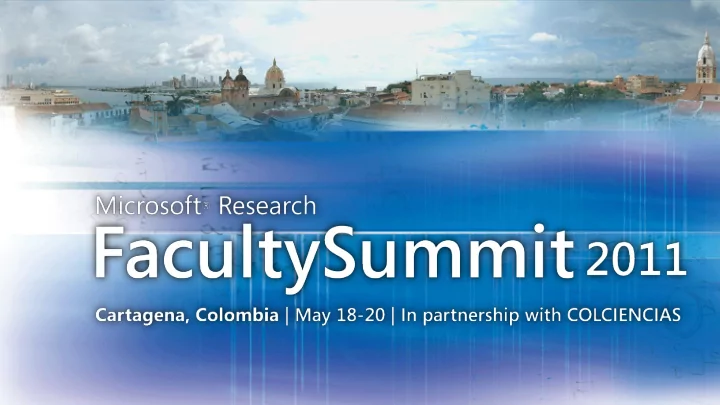

High-Fidelity Augmented Reality Interactions Hrvoje Benko Researcher, MSR Redmond
New generation of interfaces Instead of interacting through indirect input devices (mice and keyboard), the user is interacting directly with the content. Direct un-instrumented interaction Content is the interface
Surface computing
Kinect
New generation of interfaces Direct un-instrumented interaction. Content is the interface.
New generation of interfaces Bridge the gap between “ real ” and “ virtual ” worlds...
… but still confined to the rectangular screen!
An opportunity… Enable interactivity on any available surface and between surfaces.
MicroMotoCross
Augmented reality Spatial “ Deviceless ” High-fidelity
Depth Sensing Cameras
Depth sensing cameras Color + depth per pixel: RGBZ Can compute world coordinates of every point in the image directly.
Three basic types • Stereo • Time of flight • Structured light
Correlation-based stereo cameras Binocular disparity TZYX http://www.tyzx.com/ Point Grey Research http://www.ptgrey.com
Correlation-based stereo
Stereo drawbacks • Requires good texture to perform matching • Computationally intensive • Fine calibration required • Occlusion boundaries • Naïve algorithm very noisy
Time of flight cameras 3DV ZSense Infrared camera + Pulsed infrared lasers GaAs solid state shutter RGB camera 3DV, Canesta (no-longer public) PMD Technologies http://www.PMDTec.com Mesa Technologies http://www.mesa-imaging.ch
Time of flight measurement
Structured light depth cameras Infrared projector RGB camera Infrared camera http://www.primesense.com http://www.microsoft.com/kinect
Structured light (infrared)
Depth by binocular disparity Projector Camera Expect a certain pattern at a given point • Find how far this pattern has shifted • Relate this shift to depth (triangulate) •
Kinect depth camera Per-pixel depth (mm) • PrimeSense reference design • Field of View 58° H, 45° V, 70° D • Depth image size VGA (640x480) • Spatial x/y resolution (@ 2m distance from sensor) 3mm • Depth z resolution (@ 2m distance from sensor) 1cm • Operation range 0.8m - 3.5m • Best part – It is affordable - $150 •
Why sense with depth cameras? Requires no instrumentation of the surface/environment. Easier understanding of physical objects in space.
Enabling interactivity everywhere
LightSpace
LightSpace
LightSpace Implementation PrimeSense Projectors Depth Cameras
PrimeSense depth cameras 320x240 @ 30Hz Depth from projected structured light Small overlapping areas Extended space coverage
Unified 3D Space
Camera & projector calibration Depth Camera Projector & Intrinsic Projector & Intrinsic Camera Parameters Parameters T p T c Origin (0,0,0)
Camera & projector calibration Depth Camera Projector
LightSpace authoring All in real world coordinates. Irrespective of “which” depth camera. Irrespective of “which” projector.
Supporting rich analog interactions
Skeleton tracking (Kinect)
Our approach Use the full 3D mesh. Preserve the analog feel through physics-like behaviors. Reduce the 3D reasoning to 2D projections.
Pseudo-physics behavior
Virtual depth cameras
Simulating virtual surfaces
Through-body connections
Physical connectivity
Spatial widgets User-aware, on-demand spatial menu
What is missing? LightSpace Ideally • “Touches” are hand • Multi-touch blobs • All objects are 2D • 3D virtual objects • Very coarse • Full hand manipulations manipulations
Touch on every surface
Problem of two thresholds Reasonable finger thickness Surface noise
How to get surface distance? Analytically Problems: • Slight variation in surface flatness • Slight uncorrected lens distortion effect in depth image • Noise in depth image •
How to get surface distance? Empirically Take per-pixel statistics of the empty surface • Can accommodate different kinds of noise • Can model non-flat surfaces • Observations: • Noise is not normal, nor the same at every pixel location • Depth resolution drops with distance •
Modeling the surface Build a surface histogram at every pixel. Surface noise threshold
Setting reasonable finger thickness Must make some assumption about anthropometry, posture, and noise.
How good can you get? Camera above surface 0.75m 1.5m Finger threshold 14mm 30mm Surface noise 3 mm 6mm
KinectTouch
But these are all static surfaces How to allow touch on any (dynamic) surface? Dynamic surface calibration • Tracking high-level constructs such as finger posture, 3D shape • Take only the ends of objects with physical extent (“fingertips”) • Refinement of position •
Depth camera touch sensing is almost as good as conventional touch screen technology! Works on any surface! (curved, flexible, deformable, flat…)
Interacting with 3D objects
Previous approaches were 2D
Can one hold a virtual 3D object in their hand? And manipulate it using the full dexterity of your hand?
If you know the geometry of the world, you should be able to simulate physical behaviors.
Problems with physics and depth cameras Dynamic meshes are difficult • Rarely supported in physics packages No lateral forces! • Can’t place torque on an object Penetration is handled badly • Can’t grasp an object with two fingers
Particle proxy representations
But can you see 3D in your hand?
3D perception Many cues: Size • Occlusions • Can correctly simulate if you know: Shadows • • The geometry of the scene Motion parallax • • User’s view point and gaze Stereo • Eye focus and convergence •
Depth camera is ideal for this! Can easily capture scene geometry Can easily track user’s head
MirageBlocks Depth Camera 3D Projector (Kinect) (Acer H5360) Shutter Glasses (Nvidia 3D Vision)
A single user experience!
Particle proxies
MirageBlocks
Next: Grabbing Very hard problem – Working on it!
Summary 1. Interactivity everywhere 2. Room and body as display surfaces 3. Touch and 3D interactions 4. Preserve the analog feel of interactions
Come to try it yourself! MirageBlocks demo Friday 10am – 1pm
Resources to consider
Resources Kinect for Windows SDK http://research.microsoft.com/en- • us/um/redmond/projects/ kinectsdk
Resources NVIDIA PhysX SDK http://developer.nvidia.com/physx-downloads • http://physxdotnet.codeplex.com/ (.NET wrappers) • Newton Physics Game Engine http://newtondynamics.com/forum/newton.php •
Resources NVIDIA 3D Vision http://www.nvidia.com/object/3d-vision-main.html • DLP Link http://www.dlp.com/projector/dlp-innovations/dlp-link.aspx • http://www.xpand.me/ (3D glasses) •
My collaborators
? Hrvoje Benko benko@microsoft.com http://research.microsoft.com/~benko
Recommend
More recommend